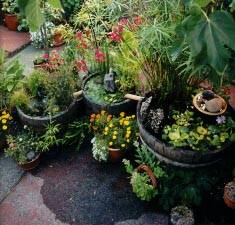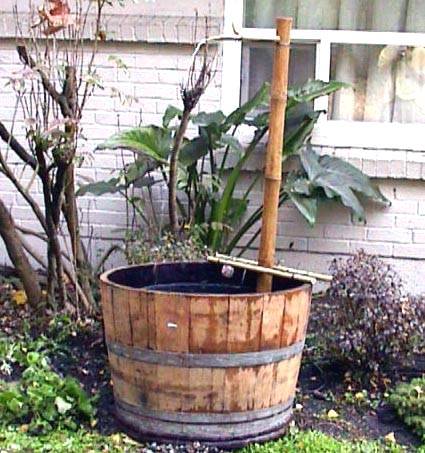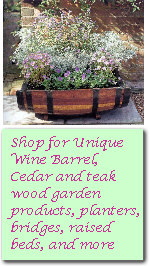

Two tier water garden w/full and half barrels
Tall bamboo spout
Container water gardening adds a unique, new group of plants
to home landscapes. Many, such as water lilies and water hyacinths, grow well in
containers. Containers are an excellent way to sample the joys of water
gardening before committing to a larger, permanent pond.
Locating Water Garden
Container
Locate your container garden so it can be seen easily from the
house or serve as a focal point, drawing visitors into the garden. Consider the
following when choosing a site for your water garden:
Most water plants require full sun for at least five hours. A
spot that is shaded in mid- to late-afternoon is ideal. Three hours of direct
light is minimum for water gardening, but it greatly limits both the number of
plant choices and flower quantity and quality.
Falling tree leaves cause extra maintenance by clogging pumps
and harming fish and plants. Keep your water garden away from overhanging tree
branches.
Easy access to a water supply is important. Water that has
evaporated from the container must be replaced to keep the water level constant.
Setting up the Water Garden
Container
The most common types of containers used are the
recycled wine barrel or you can try
other unique shape of container like the
rectangle or square cedar wood container, you might have to buy the plastic
liner for the old wine barrels, but I prefer the water tight wine barrel to
retain the authentic look of the barrel and save the money on the purchase of
liners. The wine barrels come in either half or full sizes which you may use two
different sizes to create a two tier types of water garden barrels, the setting
is unlimited, use your imagination!
There are a lot of accessory can be added to help enhance and
functioning of your water garden container like the adding of
bamboo fountains, the flow and splashing of
water oxygenate the water for plant and animal lives, the soothing sound of
water give you the peace and calm to your afternoon retreats.
Once the location is decided you can begin setting the barrels up for your water gardening, you
should elevated the barrels by placing on barrels movers or put some bricks and
short lengths of 2x4s beneath them to let the air circulate around them and keep
the water insulated from the ground. That will help to prevent your water in
your barrels from heating up by the summer heat on your concrete ground.! Even
if you were to set the barrels down on soil, we recommend that you elevate them
to reduce the risk of the barrel rotting away where it is in contact with the
ground. Also, pests would have a harder time climbing up and inside to invade
and/or damage your barrel. Remember after these barrels are filled with water,
there is no way you can move them around so
barrels movers would be ideal if you later on want to move the barrel to
another location or indoor for over winter.
Planting the Garden
Plants will not overwinter in an above-ground container in our
climate. Grow them in pots so they can be easily removed and stored for winter
in a cool place where they won't freeze.
Put a layer of garden soil in the bottom of each pot. Set
plants at the required planting depth, then fill the pots with soil. A top layer
of sand or gravel about ¼-inch deep will hold the soil in place. Don't use a
potting mix that contains perlite or vermiculite, which will float to the
surface. Also, avoid any potting mixes which contain fertilizers or chemicals
that may be harmful to aquatic life.
Saturate the soil by watering it thoroughly, then set the pots
in the water garden container. Place bricks beneath pots to adjust planting dept
for each species.
A container the size of a wine barrel will provide room
for only one water lily. Bog plants or grasses may be planted on the outer
edges, depending on the container's size.
Because a water garden is a miniature ecosystem, the plants,
water, sunlight and fish must interact together to thrive. If the water you use
is chlorinated, let it sit for 24-48 hours to permit any chlorine to evaporate
after the container is first filled. As water evaporates, replace it with
chlorinated water from the tap; chlorinated water helps to control algae until
the garden is balanced, usually 60 days. "Balanced" means that the plant and
animal life will hold algae in check.
Many city water supplies have chloramine added, which is a
more stable form of chlorine. If you use chloramine treated water, you will need
to purchase a product to remove the chlorine. These are available from garden
centers that sell water gardening supplies. Water added during the season to
maintain the water level does not need to be treated.
The Plants
Several types of plants are used in the water garden, including deep-water
plants such as water lilies. Water lilies provide colorful, fragrant
additions to a water garden. They prevent oxygen loss from the water surface and
keep the water cooler. Tropical lilies are more fragrant, have larger blooms,
bloom more frequently and come in more colors than hardy lilies. Plant them when
temperatures reach 75° during the day and 65° at night. They will die when frost
hits, so they need to be stored inside or treated as annuals.
Tropical water lilies require a foot of water over the crown.
They need at least four hours of direct sunlight. Either late afternoon or early
morning sun is adequate. Recommended varieties for a barrel garden include:
 |
'Yellow Pigmy', a miniature that is a prolific and
consistent bloomer.
|
 |
'Froebeli', a red lily that can stand the heat that might
build up in a small container. It is less prolific than Yellow Pigmy.
|
 |
'Joanne Pring', a pink miniature that will need to be
divided after a year or so. |
Hardy water lilies bloom longer in our climate, but alternate
several weeks of "rest" with several weeks of bloom throughout the growing
season. Plant them in 18 inches of water. Lotus is not recommended for above-
ground containers. It needs 2-3 feet of water.
Submerged plants, also called
oxygenators, are commonly used in large water gardens to clean the water by
absorbing excess nutrients, slowing algae growth, and replenishing the oxygen
supply. For container gardens, use an aquarium pump.
Floating plants, such as water
hyacinths, floating heart, and floating water ferns also reduce algal growth.
Water hyacinths grow well in a barrel garden. They reproduce freely and may need
to be thinned out as summer progresses. The attractive lavender flowers have run
rampant in some southern waterways, but they're not a problem here because they
won't survive our winters. They can be anchored in place with a light piece of
nylon string tied to a brick.
For each square yard of water surface, you may use two bunches
of oxygenation plants, one medium to large water lily, and 12 water snails.
Fish and Snails
After stocking the tub with plants, wait 4-5 weeks before adding fish. The
plants must become established first.
Snails eat algae, fish wastes, and decaying vegetable matter.
Fish help keep the water garden a healthy ecosystem. They trim excess foliage,
and eat algae, mosquito larvae and other insects. Most aquarium fish are not
hardy enough to survive a water garden.
A good rule of thumb is to use 1-2 inches (length) of fish for
every square foot of water surface.
Gambezi (Gambusia affinis), also known as the mosquito
fish, are effective at controlling mosquitos by feeding on the larvae. They are
black fish that provide entertainment by flipping and jumping. They may even
reproduce in water gardens. Over winter, keep them in an aquarium as they will
not survive in a container garden.
Guppies will thrive in a small garden. Koi or goldfish are not
recommended for a small water garden, as they can not tolerate the extremes in
temperatures and gas.
If you don't plan to overwinter fish in an aquarium, bait shop
minnows provide inexpensive insect control. Various shiner and fathead or
crappie minnows work well. Sucker minnows are not recommended.
Acclimate fish to pond life by floating them in a plastic bag
in the pond for 15-20 minutes. Fish will feed on algae and plants, but some
people enjoy feeding them. This is fine as long as the food is limited so none
is left to decay in the pond.
Overwintering the Garden
Rather than overwinter plants, you may wish to treat them as annuals. Otherwise,
you'll need to bring plants inside. Water lilies may be overwintered if cleaned
and stored in moist sand in a cool, dark basement. Other tropical plants may be
kept in crocks full of water in full sun and grown as houseplants. Free floating
plants, such as water hyacinths, can be overwintered in a tub of water in a
sunny place indoors.
Bait minnows may be overwintered in an aquarium, used for
fishing bait, or discarded
![]() Gardeners' Corner
Kids'
Garden
Sustainable Garden
Contact Us
Gardeners' Corner
Kids'
Garden
Sustainable Garden
Contact Us![]()



